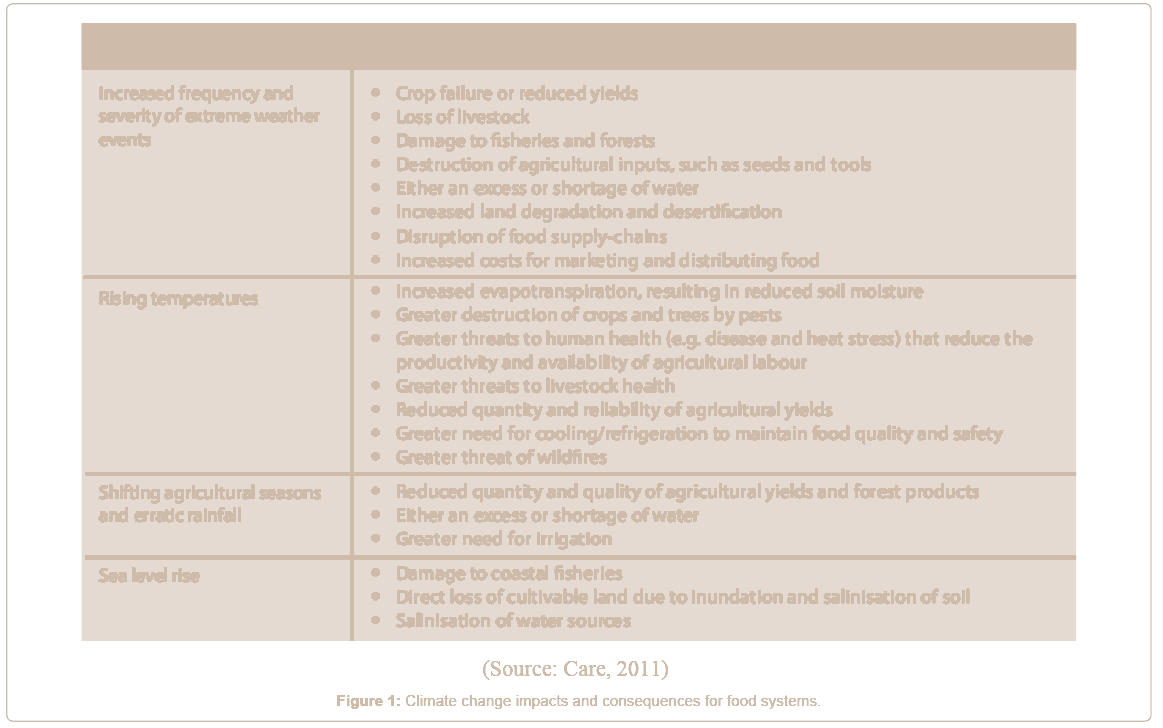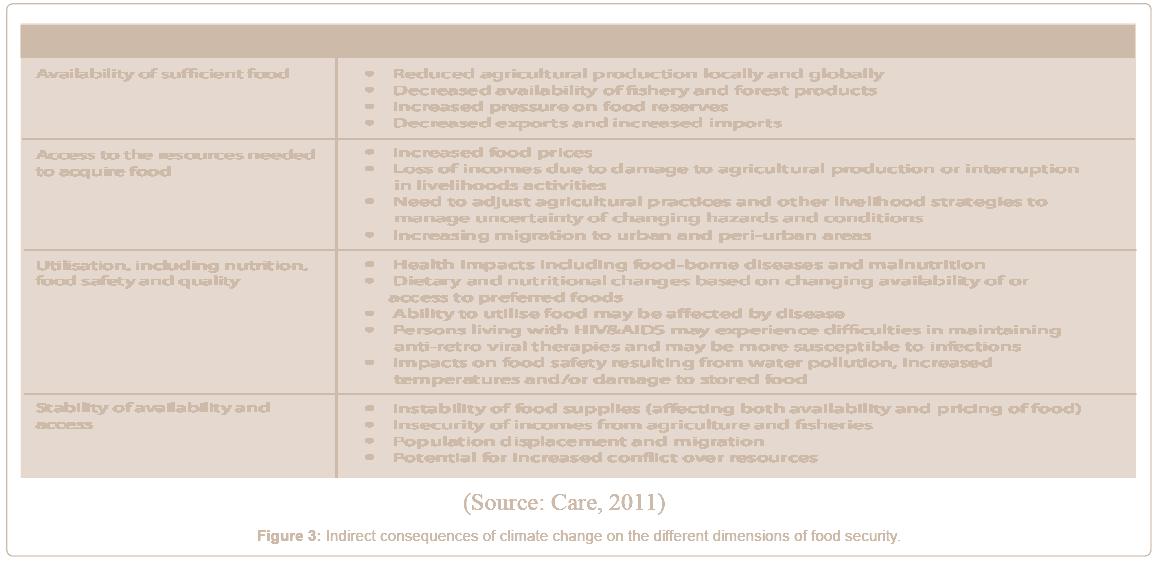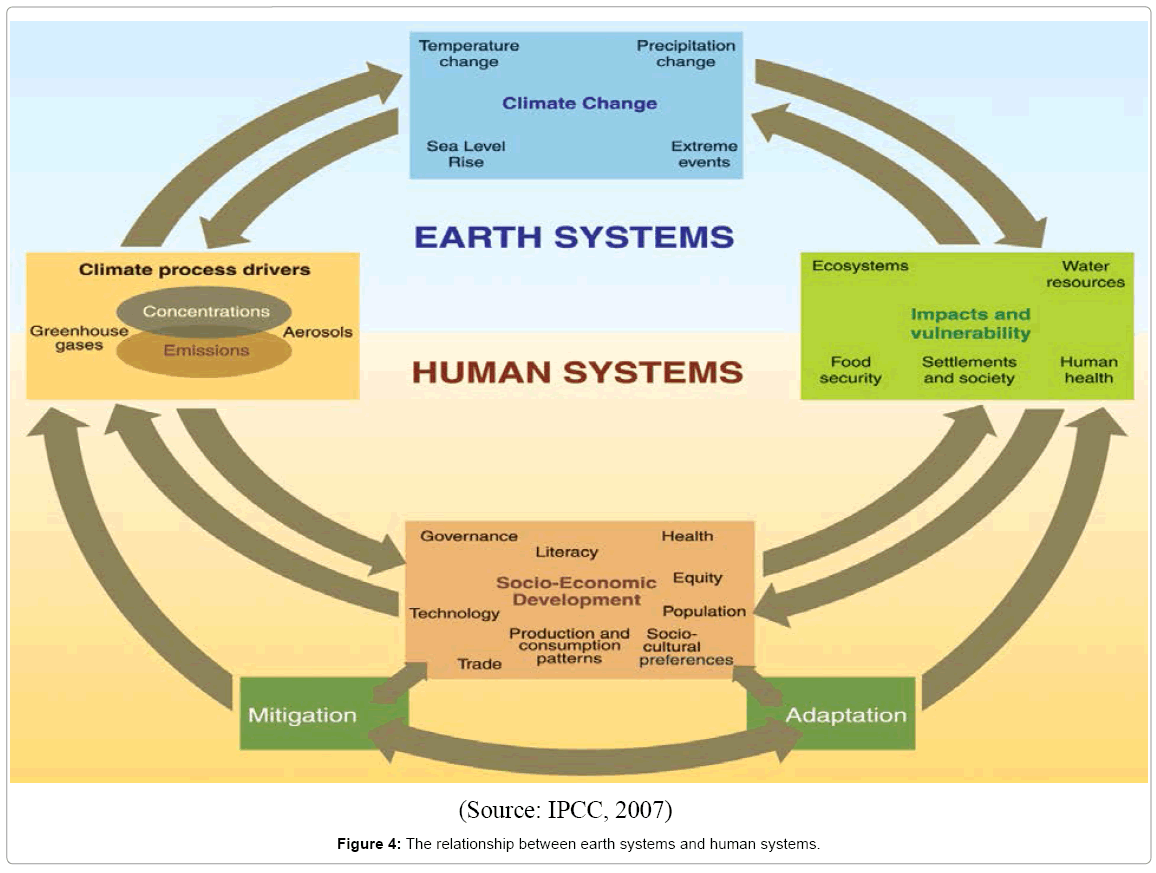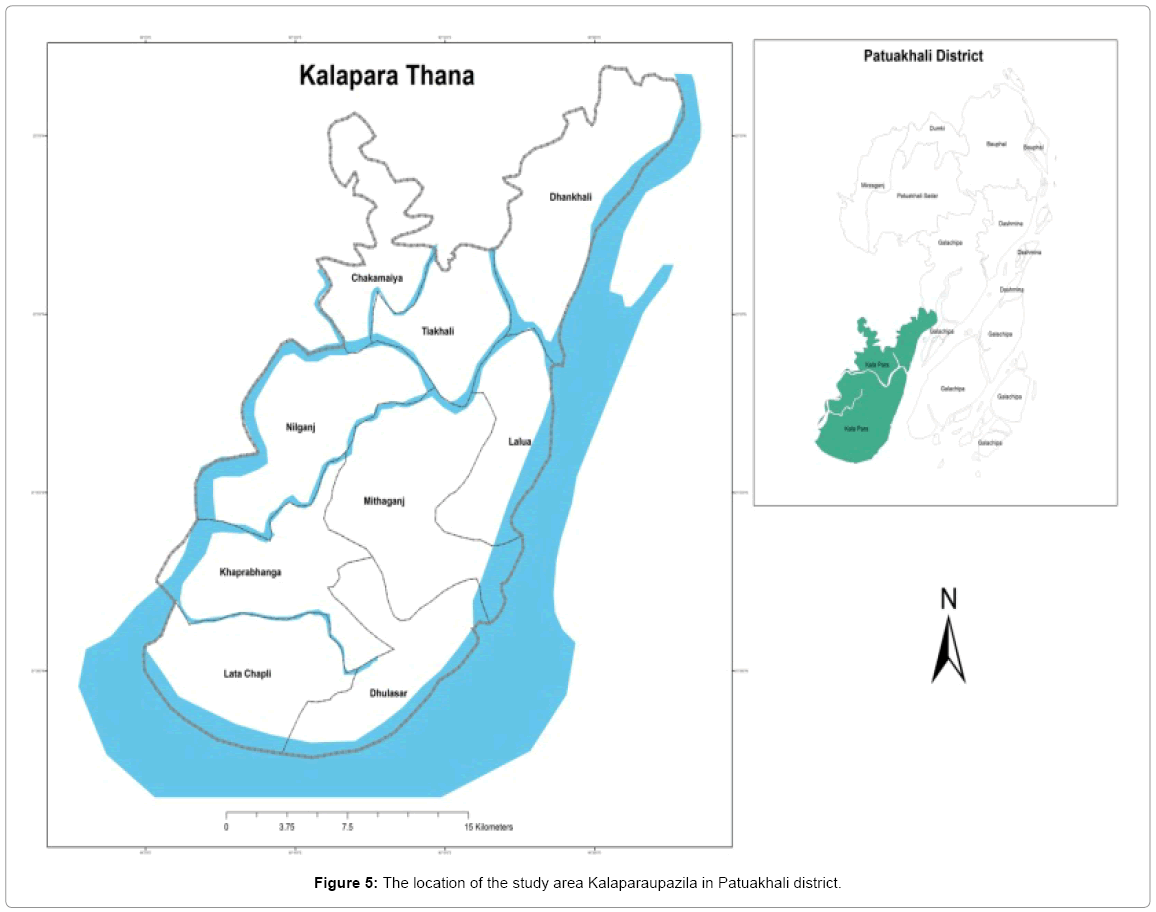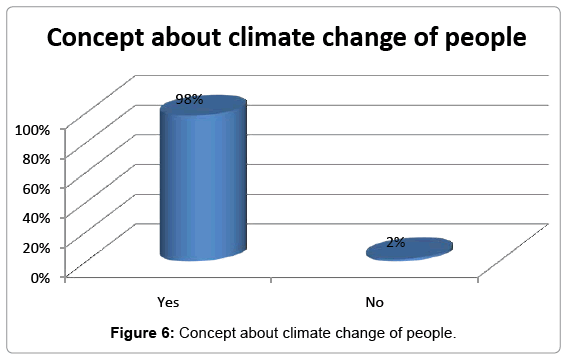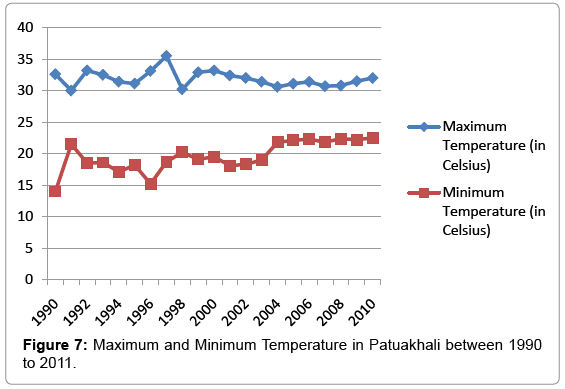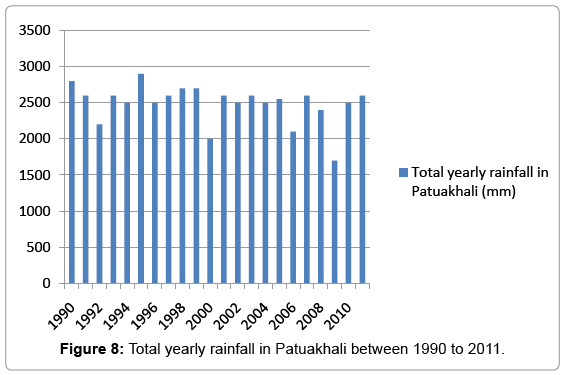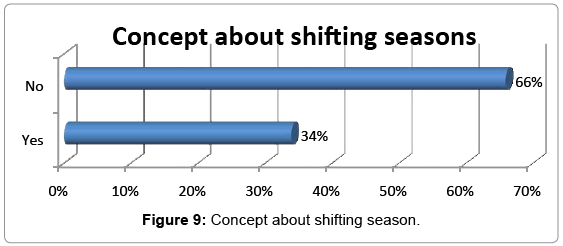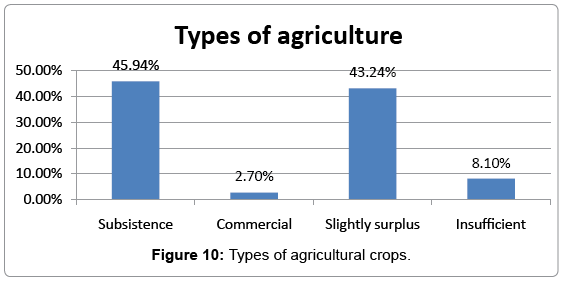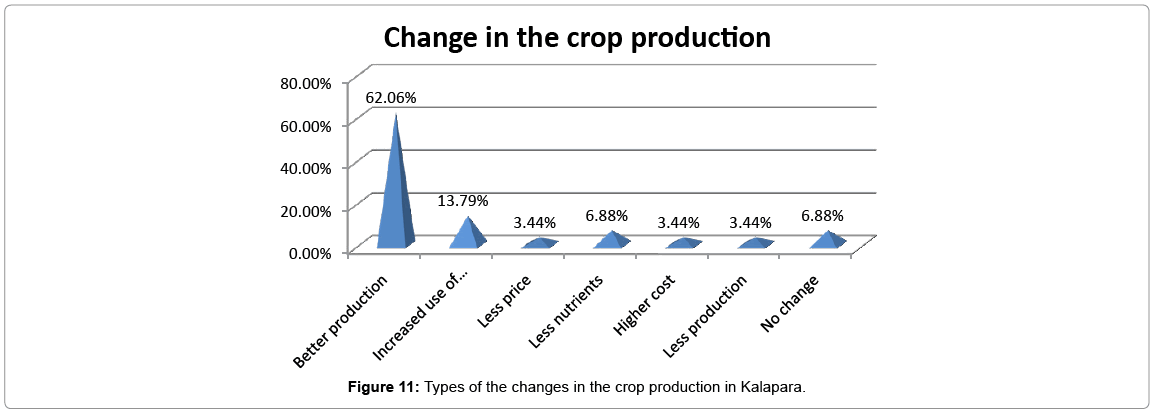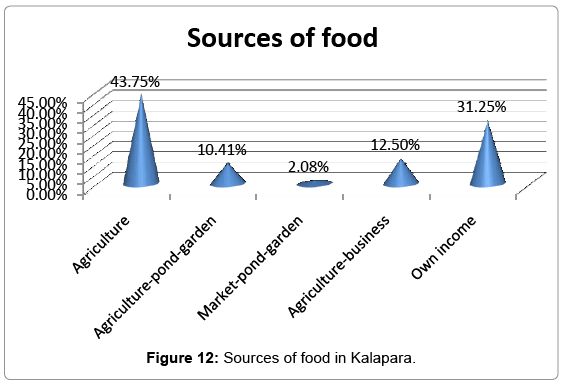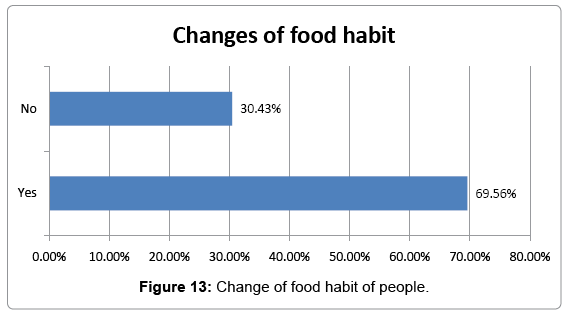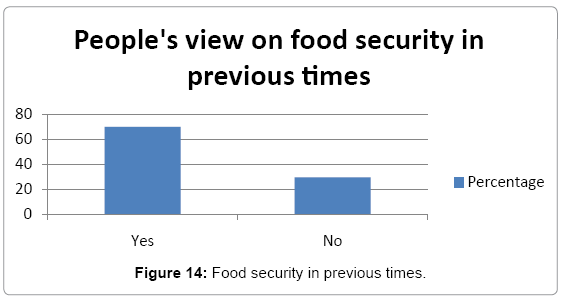Climate Change and Its Impact on Food Security in Bangladesh: A Case Study on Kalapara, Patuakhali, Bangladesh
Received: 29-Jul-2013 / Accepted Date: 26-Aug-2017 / Published Date: 01-Sep-2013 DOI: 10.4172/2157-7617.1000155
Abstract
The paper analyses the impacts of climate change and its impact on food security in the Kalapara Upazila of Patuakhali district in Bangladesh. The paper shows current climate change scenarios for Kalapara, analyses the relationship between climate change scenarios and agricultural production and then prescribe adaptive measures to climate change. Historical yearly temperature and rainfall data from Bangladesh Meteorological Department (BMD) and crop yield data from the census of agriculture zilla series, Patuakhali, year book of agricultural statistics and agricultural ministry of Bangladesh were used. A questionnaire survey was also conducted to gather farmer perceptions on climate change in addition focus group discussions were held with selected farmers in the Upazila. The results showed evidence of climate change through analysis of climate data, crop yields and farmers perceptions. Evidence was manifested through the temperature increase, increasing frequency of natural disaster and irregular rainfalls, which are directly influenced the condition of food security of Kalapara Upazila. It was the concluded that climate change occurring in Kalapara Upazila has resulted in significant decline in agricultural production. The paper is also showed the comparison of sources of food and production amount between past and present. The people\'s perceptions show that the temperatures are rising, timely rainfall is not available and crop production seasons are shifting. The lessons show that people are aware of climate change and its impacts on food security. But lack of proper knowledge is the main causes to adapt to these changes.
Keywords: Agricultural production; Climate change; Food security; Adaptation; Kalapara; Upazila
10935Introduction
Climate change has a great impact on the various sectors. The agricultural sector is one of these. The relationship between climate change and agriculture is a vital issue for food security. Impacts of the climate change on the agricultural sector can be explained in both positive and negative ways. Both land use pattern and the productivity of crops are likely to change under global warming. “Climate change refers to the phenomenon that is causing the earth to become warmer, meaning that our climate and our weather systems are changing towards a warmer state” [1]. Climate change is changes in atmospheric concentrations of the various greenhouse gases which enhance the average temperature of the earth [2]. From very ancient times to present times the climate is changing. But there are two types of climate change one is natural climate change and another is anthropogenic climate change. The United Nations Framework Convention on Climate Change (UNFCCC) defines climate change as: “a change of climate which is attributed directly or indirectly to human activity that alters the composition of the global atmosphere and which is in addition to natural climate variability observed over comparable time periods”. In other words, the FCCC uses the term climate change to mean only those changes that are brought about by human activities [3]. South Asia is the most vulnerable region of the world to climate change impacts [4]. The international community also recognizes that Bangladesh ranks high in the list of most vulnerable countries on earth [5] in present times the food security is susceptible to climate change. Since all elements of food security directly or indirectly are affected by anthropogenic climate change. For defining the food security some of basic terms have to be mentioned. These are food availability, food accessibility, nutritious dietary and the satiety. “Food security depends on more socio-economic conditions than on agro climatic zones and on access to food rather than the production or physical availability of food”.
From Figure 1 it stated that, to evaluate the potential impacts of climate change on food security, “it is not enough to assess impacts on domestic production in food-insecure countries. One also needs to (i) assess climate change impacts on foreign exchange earnings; (ii) determine the ability of food-surplus countries to increase their commercial exports or food aid; and (iii) analyses how the incomes of the poor will be affected by climate change [6]. The total food production conditions, food availability condition, food access condition of Bangladesh are three main terms for discussing the food security. The national gap of the food production and the export of the food items and amount are also included here [7]. Unless the world comes to its aid, the vulnerability of Bangladesh’s agriculture sector to climate change could spell severe consequences for its millions of people, who stand to lose their main source of livelihood [8].
Increased temperature not only directly reduce the crop production but also it has an indirect impact by stimulating the breeding of harmful insects, pests etc. Which are detrimental for the agricultural production? Figure 2 show the global average temperature change of the world. Increases in precipitation extremes are very likely in the major agricultural zones of south Asia. Four factors characterizing the atmosphere strongly influence plant growth. They are carbon dioxide, rainfall, light intensity and temperature [9].
Increase in annual rain fall with global warming would increase moisture supply in the soil. It could be beneficial for the dry season crops and also in the pre monsoon and post monsoon periods [9] from Figure 3 it is observed that the indirect consequences of climate change on the different dimensions of food security.
Climate change affects agriculture and food production in complex ways. In the Figure 4 the relationship between earth systems and human systems is very complex. It affects food production directly through changes in agro-ecological conditions and indirectly by affecting growth and distribution of incomes, and thus demand for agricultural produce. Impacts have been quantified in numerous studies and under various sets of assumptions. As election of these results are presented in quantifying the impacts on food security. Here it is useful to summarize the main alterations in the agro-ecological environment that are associated with climate change [10].
As Bangladesh is a developing country and also dependent on other countries for the food so the impact of climate change will be much greater. It is anticipated that the consequences of climate change will increase livelihood insecurity, malnutrition, unemployment, lack of safe drinking water and water-borne diseases in Bangladesh and about one third of the population would be vulnerable to climate change and sea level rise [3].
In Bangladesh, the overall impact of climate change on agricultural production will be negative [11]. With over 35% of Bangladesh is suffering from malnourishment [12], the threat of increased hunger from reduction in agricultural production would suggest the inclusion of agriculture as one of the major vulnerabilities facing the country.C
“Adjustment in natural or human systems in response to actual or expected climatic stimuli or their effects, which moderates harm or exploits beneficial opportunities” [13]. It involves learning to manage new risks and strengthening resilience in the face of change [14]. In a nutshell adaptation is being better prepared or adapting to climate change, not fighting it, but learning to live with it [15].
In countries where the majority of poor people depend on agricultural income, proposed climate change adaptation strategies centrearound increasing agricultural productivity and making agriculture, including livestock, fishery and forestry, less vulnerable to climate stress and shocks [16].
Modern technological advances can play a vital role to choose the appropriate adaptive measures. One of the best ways to adapt to climate change is to involve people at the grass-root level. The people of Bangladesh are very enterprising and innovative. They have been living with disasters for a long, long time [17].
Objectives and theoretical foundations
The objectives of this study are:
1. To determine the climatic change scenarios for Kalapara Upazila.
2. To determine changes in agricultural production output under changing climatic conditions in KalaparaUpazila.
3. To determine farmers perceptions on climate change and how it is affecting food security in this area.
4. Suggest possible adaptation techniques for the farmers in the area.
This paper attempts to answer the following questions in particular:
1. Is there a significant relationship between agricultural output and climate change in Kalapara Upazila?
2. What do the farmers perceive the signs of climate change and food security of Kalapara Upazila?
3. Do farmers perceive climate change to have occurred already and if so have they begun to adapt?
Total food security condition in Kalapara Upazila.
Methodology and Materials
Crop yield data for areas in Kalapara Upazila obtained from Bangladesh Bureau of Statistics (BBS), 1983-84, 1996, 2008. Census of Agriculture Zilla Series, Patuakhali, Year book of agricultural statistics and Agricultural Ministry of Bangladesh.
The rainfall and temperature data were Bangladesh Meteorological Department (BMD) and Bangladesh Bureau of statistics (BBS). The rainfall and temperature data were used to determine climatic variability and climatic scenarios for Kalapara in Patuakhali district [18].
The study also made use of questionnaires, focus group discussion and Experts interviews with key informants.
The study made use of the materials available in the following ways:
1. A questionnaire survey was used in the study to obtain information related to Kalapara farmer’s perception on climate change. The questionnaire survey was carried out after a pilot studies were carried out in each area. The target population was mainly the oldest people of a selected community because they were considered to be able to give a pattern of weather changes over a longer period of time which was considered a more reliable picture of changes in climate.
2. Considering the population of this most useful population (people over the age of 50) 200 people was confidently selected as the best sample size that would give the best trade of between cost and representativeness of the sample.
3. About all villages were visited in the area. A base map of Kalapara Upazila was imported into a Geographical Information Systems (GIS).
4. A set of questions were also prepared that probed farmers on the climatic changes and crop productivity and these were used in focus group discussions.
Study area
Figure 5 shows the location of the study area. Patuakhali is a district in South-western Bangladesh. It is a part of the Barisal Division. Kalapara Upazila (PATUAKHALI district) with an area of 483.27 square km is bounded by AMTALI Upazila on the north, the BAY OF BENGAL on the south, Rabnabad channel and GALACHIPA Upazila on the east. Main rivers are Andharmanik, Nilganj and Dhankhali.
Logics behind selection of the study area
Patuakhali is one of the coastal districts in Bangladesh. It is predicted that, for the climate change the coastal area of Bangladesh will be affected. As the most of the people in Patuakhali are engaged in agricultural sector, so the impact of climate change may be experienced here. It is studied that for the climate change the agricultural sector will be affected, which will create extra pressure on the food security. Kalapara is one of the Upazila in Patuakhali, which is located very near to the Bay of Bengal. So the impacts of the climate change can be earnestly experienced here.
Result and Discussion
The coastal areas are much more susceptible to the recent anthropogenic climate change. Whatever the educational background of the people, most of the people about 98% of Kalapara are aware about the climate change. (Figure 6).
According to farmer’s view the main indicators of the climate change are temperature rising, erratic rainfall and natural disaster activities distinctively 30%. And also shifting season is one of the indicators (Table 1).
| Indicators of climate change | Percentage |
|---|---|
| Temperature rising | 30 |
| Low rainfall | 30 |
| Shifting season | 10 |
| Frequent occurrences of natural hazards | 30 |
| Increase the level of tidal wave | 0 |
| Others | 0 |
Table 1: Indicators of climate change.
From Figure 7 it is showed that the temperature is continuously rising. Also it is transparent from analysis temperature data of 1990 to 2011 that the gap between maximum and minimum is extended. Large gap shows the abrupt climatic situation.
Due to climate change the rainfall pattern expected to be dramatically changed throughout the globe. The rainfall is decreasing than the average. They also expressed that, during the summer season they experienced insufficient rainfall in recent times (Figure 8).
Due to the climate change the natural hazards are also increasing. In the study area respondents experienced a wide variety of the hazards which are occurring frequently. Among these hazards cyclone, kalboishakhi, flash flood etc. are prominent. Despite these people also experienced that a higher sea-level rise during tides compared with the past. The places are selected to give the idea about sea level rise in Bangladesh that is situated besides this area.
Shifting season is a good indication for climate change. About 66% people and 34% people are given both negative and positive views about shifting seasons respectively. From the respondents about 34%, it can be known that the people are not able to identify the seasons like the past. In the present times people can identify only 3 seasons. Duration of the winter season are decreased on the other hand, the nature of the rainy season is also changing (Figure 9).
The agriculture of study area has different types. Most of the people about 46% are dependent on subsistence agriculture. There are a higher percentage of people about 43% whom agriculture is under the slightly surplus condition. There is seen the lower percentage for insufficient production. So this situation is occurring due to blessing of modern technology in agriculture than the past times (Figure 10).
People are cultivating various agricultural products. (Table 2) The prominent crops of the area are IRRI. These crops are commonly seen in most of land area. aus is mainly cultivated in areas 0-10 acres of land. On the other hand aman is mainly cultivated in areas more than 10 acres. There are some other minor crops (pulse, nut) which are mainly cultivated below 10acres of land. 10 years ago the contribution of IRRI was much better in all of the areas. The local variety of crops was seen in those times. As the production of the local variety is not satisfactory so people are deviating from local variety to the HYV crops (Table 3).
| Types of crops | Percentage |
|---|---|
| IRRI | 45 |
| Shorna | 3.3 |
| Bhojon | 1.67 |
| Kajol | 1.67 |
| Aus | 10 |
| Amon | 16.67 |
| Pulse | 6.67 |
| Nut | 3.30 |
| Local rice | 1.67 |
| Vegetable | 3.30 |
| Pepper | 3.30 |
| Rabi crops | 3.30 |
| Total | 100 |
Table 2: Types of agriculture production.
| Area under crop production about 10 years ago | Present area under crop production | |||||
|---|---|---|---|---|---|---|
| Types of crops | 0-1 acre Percentage | 1-10 acre Percentage | 10+ acre Percentage | acre Percentage | 1-10 acre Percentage | 10+ acre Percentage |
| IRRI | 58.33 | 71.42 | 50 | 58.33 | 62.06 | 33.33 |
| Shorna | 8.33 | 3.34 | ||||
| Bhojon | ||||||
| Kajol | 8.33 | |||||
| Aus | 8.33 | 8.33 | 6.89 | |||
| Amon | 7.14 | 33.33 | 13.79 | 66.67 | ||
| Pulse | 14.28 | 8.33 | 13.79 | |||
| Nut | 16.67 | |||||
| Local rice | 16.67 | |||||
| Vegetable | ||||||
| Pepper | 8.33 | |||||
| Rabi crops | 16.67 | 7.14 | ||||
| Total | 100 | 100 | 100 | 100 | 100 | 100 |
Table 3: Comparison of past and present area under crop production.
Most of the respondents said that more than 30 mounds of rice are harvested per acre from HYV IRRI. As the IRRI is cultivated by maintaining the scientific methods so the output of this crop is much better than the other crops. But the other crop variety of the rice is less cultivated by the farmers due to the less output than the IRRI.
But 10 years ago the harvest of the IRRI was less than the present harvest. In that time the local variety like aus and aman were the prominent crop varieties. The production of the local variety was also less than the present times. There are a lot of factors behind these facts. 10 years ago people were not so much concerned about the agricultural production. In that time most of the agricultural land was the non arable. For the increasing population pressure they were concerned about the intensive agriculture (Table 4).
| Crop production in mounds about 10 years ago | Present crop production in mounds | |||||
|---|---|---|---|---|---|---|
| Types of crops | 0-10 mounds Percentage | 10-30 mounds Percentage | 30+ mounds Percentage | 0-10 mounds Percentage | 10-30 mounds Percentage | 30+ mounds Percentage |
| IRRI | 46.42 | 60 | 100 | 37.5 | 53.57 | 66.67 |
| Shorna | 3.57 | 11.11 | ||||
| Kajol | 10 | 3.57 | ||||
| Aus | 7.14 | 12.5 | 7.14 | 11.11 | ||
| Amon | 14.28 | 20 | 21.42 | 11.11 | ||
| Pulse | 14.28 | 12.5 | 10.71 | |||
| Nut | 3.57 | |||||
| Local rice | 10 | |||||
| Rabi crops | 10.71 | 37.5 | 3.57 | |||
| Total | 100 | 100 | 100 | 100 | 100 | 100 |
Table 4: Comparison of past and present crop production in mounds.
For the time being crop production rate is rapidly changing. The people of the study area are expressing the various concepts about the changing pattern of the crop production. The maximum people about 62% expressed that they experienced higher production in their agricultural field than past times. This situation is seen due to the green revolution. Despite these the agricultural extension is taking different initiatives to increase the crop production. Some people about 4% also told that they experienced low production of agricultural products. Whatever, the situation but it can be certainly told that, the cost of the agricultural activities is also increasing for using the modern technology? (Figure 11).
Though there is seen the both higher and lower production of agricultural products but the farmers experienced different causes Agriculture of our country is not much modernized and also nature dependent, so, for slightly change of the climate can bring a great impact on agriculture. Though the production of rice is increasing but this production is hampered due to the occurrence of natural hazards. The normal system has changed due to climate change so this can be a cause for the low production. In the study area people are also trying to address the impacts of climate change. For this reasons they are trying to cultivate HYV rather than the local variety, so the local variety of the agricultural products are decreasing. On the other hand due to the cultivation of HYV the costing of the production is rapidly increasing (Tables 5 and 6).
| Causes | Percentage |
|---|---|
| Salinity | 29.23 |
| Pest attack | 27.69 |
| Water logging | 9.23 |
| Better training | 1.53 |
| Low rainfall | 27.69 |
| Modern technology | 1.53 |
| Less water availability | 3.07 |
Table 5: Causes of the production changing in Kalapara.
| Impacts | Percentage |
|---|---|
| High production | 19.56 |
| Higher costing | 13.04 |
| Higher uses of chemicals, pesticides, fertilizer etc. | 15.21 |
| Loss of local variety | 13.04 |
| Less production | 30.43 |
| Loss of fertility | 4.34 |
Table 6: Impacts of climate change on agriculture in Kalapara.
As the study area is a coastal area so there is seen two types of the fishing like cultured fishing and captured fishing. From the view of respondents it can be said that in the present times there is seen the prominence of the culture fishing rather than the capture fishing. In past times people were reluctant about the culture fishing in their homestead ponds. But recent times the people are much interested about the culture fishing. Decreasing trends of the capture fishing but increasing in the culture fishing is experienced in study area. Due to climate change the production of capture fishing is decreasing and for this reason people are giving more emphasis on the culture fishing for fulfillment their protein demand (Table 7).
| Present fish production condition | Fish production condition 10 years ago | |
|---|---|---|
| Types | Percentage | Percentage |
| Pond | 88 | 61.53 |
| River | 8 | 30.76 |
| Marine | 4 | 7.69 |
Table 7: Comparison of fish production between Present to past.
Due to climate change, a great variety of changing is observing by the people in fisheries sector. Maximum respondents about 43% supposed that their fish production is increasing in the recent times. This may happen due to peoples more consciousness about the culture fishing rather than the capture fishing. On the other hand the people are also trying to use different types of modern technologies for the culture fishing. Extinction of marine and river fish species are observing. Breeding is also hampered due to low rainfall (Table 8).
| Types | Percentage |
|---|---|
| High production | 42.30 |
| Less production | 34.61 |
| Diseases | 7.69 |
| Death of fishes | 3.84 |
| Low growth rate | 3.84 |
| No change | 7.69 |
Table 8: Types of changes in the fishing in Kalapara.
There are a lot of causes behind the changes in fisheries sector. One fourth of respondents supposed that the production of the culture fishing is increasing for using of modern technologies. One fifth ofrespondents experienced that the production is hampering due to low rainfall and diseases. The production is also decreasing due to salinity intrusion, the occurrences of the flood etc. causes (Table 9).
| Causes | Percentage |
|---|---|
| Using the modern technology | 25.80 |
| Low rainfall | 12.90 |
| Diseases | 9.67 |
| Capturing the fry | 3.22 |
| Competition among the fishermen | 9.67 |
| Lower current | 3.22 |
| Decreasing the depth of water bodies | 3.22 |
| Flood | 9.67 |
| Don’t know | 9.67 |
| Salinity | 12.90 |
Table 9: Causes of the changes in fishing.
Due to climate change fisheries sector is much susceptible. About 55% respondents believe that production of fishes are decreased simultaneously 23% are agreed that the production is increased. In the study area it was seen that the production of capture fish is decreasing on the other hand the production of capture fish is decreasing. For high rate of culture fishing the production costing is also increasing (Table 10).
| Impacts | Percentage |
|---|---|
| Higher production | 22.72 |
| Lower production | 54.54 |
| Higher costing | 4.54 |
| Higher culture fishing | 4.54 |
| diseases | 13.63 |
Table 10: Impacts of climate change on fish production.
People of Kalapara are rearing different types of the livestock. Among these hen and duck are containing the major portion about 80%. Despite these there are cow, goat, sheep etc. About the 10 years ago there were more livestock in study areas. In present times people are not interested to rare the livestock. There are a lot of causes behind these factors (Table 11).
| Types | Number of livestock about 10 years ago | present number of livestock |
|---|---|---|
| Percentage | Percentage | |
| Cow | 12.43 | 10.45 |
| Goat | 4.86 | 4.92 |
| Sheep | 0.22 | 0.20 |
| Duck | 36.62 | 38.09 |
| Hen | 45.30 | 42.41 |
| Buffalo | 0.55 | 0.50 |
| Others | 0 | 3.41 |
Table 11: Comparison of livestock between past to present.
Among the different causes death of livestock is main reason about 49% respondents believe this statement. In present times the propensity of different diseases are increasing. Despite these new diseases are also spreading among the livestock. Food of the livestock is also decreasing due to increasing salinity. So, for the scarcity of food population of livestock is decreasing. Some people about 16% and 2% are also selling their livestock for their own carelessness and higher rearing costs respectively (Table 12).
| Causes | Percentage |
|---|---|
| Death for diseases | 48.64 |
| Selling for lone | 8.10 |
| Carelessness | 16.21 |
| Death for hazard | 13.51 |
| Lack of food | 8.10 |
| Higher rearing cost | 2.70 |
| No change | 2.70 |
Table 12: Causes of changing in livestock.
For describing food security condition it is very important to know about meal taken by the people in a single day. From the respondents it can be known that maximum people can manage the food for the 3 times a day. But among them some people hardly can manage the food for 3 times a day. Though people can manage food for three times in a day but a good number of people are suffering from the malnutrition. The maximum people about 70% of Kalapara are dependent on fishrice- vegetables menu for their regular dietary. Though the menu is satisfactory but fish taking tendency is decreasing among the people due to the unavailability and higher prices of fishes. The respondents told that though they are consuming fishes but this is not sufficient for them. Despite these meat and milk taking tendency are also decreasing among the people for same causes. So the nutritious status of the people is degrading.
Though, the percentage of fish-rice vegetable taking tendency was lower in the past times than the present times but the notorious food were available in that times. The people could consume the meat, milk, fruits in those times. So the food security condition was much better in the past times than the present times (Table 13).
| Menus | Menus of the 10 years ago | Present Menus of the people |
|---|---|---|
| Percentage | ||
| Rice-vegetable | 18 | 16 |
| Fish-rice-vegetable | 54 | 70 |
| Fish-rice | 0 | 6 |
| Rice-vegetable-meat | 24 | 6 |
| Fish-rice-vegetable-milk | 4 | 2 |
Table 13: Comparison between past and present Menus of the people.
About one-fifth of respondents are agreed that their present food menu is bad than the past times, on the other hand four-fifth of respondents are agreed that their past food menus were good and the vice versa. So from this statistics it can be said that present food security condition is facing agreat threat due to the climate change and other socio-economic factors (Table 14).
| Condition | Time | Comparison of food menus from present to past | |
|---|---|---|---|
| Good Percentage | Bad Percentage | ||
| Present | 21.05 | 81.08 | |
| Past | 78.94 | 18.91 | |
Table 14: Condition of food menus from present to past.
Maximum people are dependent on agriculture for their livelihood. Despite these people are also dependent on the single source of income. So it is very risky for future survival. As agriculture is the most susceptible sector to climate change so, the probability of food insecurity situation is increasing. On the other hand one third of the people is dependent on own income (day labor) so; it is also susceptible to climate change (frequent occurrence of hazards) (Figure 12).
Consumption pattern of the people is changing for various reasons. According to the question about changing of food menu more than two third of people agreed that their food menus were changed from the past times. One third respondents told their food habit is statics. As the prices of essential food items are increasing rapidly in the present times so it is very tough to poor people to buy all of nutritious food menus for fulfilling their demand (Figure 13).
Maximum people about 60% of the area are telling that food habit is changing due to increasing trends’ of commodities prices. In recent times every commodity is selling more than the value of past. The national inflation rate is about 10%. So price hiking is a common phenomenon. About 14% people are changed their food habit for the less income. Despite this there are about 11% who are improved their food habit for their higher income. Some respondents are blamed the less production for the food habit changing (Table 15).
| Causes | Percentage |
|---|---|
| Low consumption | 5.71 |
| High income | 11.42 |
| High price | 60 |
| Less production | 5.71 |
| Good food availability | 2.85 |
| Less income | 14.28 |
Table 15: Causes of food habit change.
As the price of commodities is increasing so food accessibility of people are facing a great threat. In this situation people of higher income range will be able to buy their commodities and low income range people will face a great problem to fulfill their food demand. So food security condition is becoming a great challenge to the people.
Most of the people about 70% of Kalapara are believed that they were in food secure condition in previous times. But in the present times food security condition is degrading for climate change and other reasons (Figure 14).
As agricultural sector is most vulnerable sector due to impacts of climate change so adaptive measures are essential to combat adverse situations. Govt. has taken many measures in agricultural sector. For these measures the impacts of climate change are not severely felt. In some parts, production of the crops is increasing for these adaptive measures.
Most of the farmers about 43.9% are taking modern technology. 21.95% people are taking HYV seeds. Some parts of the people about 7.31% are taking saline tolerant variety etc. for the adaptation in agriculture. People are also taking the training about modern farming system to reduce the probable impacts of climate change (Table 16).
| Types | Percentage |
|---|---|
| Modern technology | 43.9 |
| Hybrid seed | 21.95 |
| Seed conservation | 7.31 |
| ICM training | 4.87 |
| Tree plantation | 4.87 |
| Awareness building | 2.43 |
| Irrigation | 4.87 |
| Beribadh construction | 2.43 |
| Saline tolerant variety | 7.31 |
Table 16: Adaptation to agriculture for climate change.
The people of Kalapara are taking different types of adaptive measures to combat climate change. The local fisheries offices are helping the affected people. In that area the fisheries training institute and a great number of hatcheries are seen. So the different saline tolerant fishing procedures are taking by people. Sometimes fishermen are taking training for good fish production (Table 17).
| Types | Percentage |
|---|---|
| Providing good fry and food | 42.85 |
| Trainings | 35.71 |
| Irrigation facility | 14.28 |
| Cage fishing | 7.14 |
Table 17: Adaptation to fisheries.
From the primary data it can be said that production of different agricultural crops are increased with times though the people are experiencing the impacts of climate change. In recent times number of population is increasing rapidly so people are taking extra initiatives to increase the production. On the other hand different climate resilient technologies are now using by people so the production of crops are increasing. On the other hand the impacts of climate change in Kalapara are not extreme. From these situations it can be said that food production of the crops is improving. But food security is not only dependent on the food availability but also some other factors. Due to the global climate change the food supplies are hampering. Despite this for the frequent occurrence of disasters the situation becomes worse. The prices of the commodities are increasing and for this reason people are reducing their consumption. Ultimately the food security condition is degrading. For combating this situation Govt. should take some pragmatic steps to ensure the food security.
Conclusion
For the climate change coastal communities are mainly victimized. Their livelihood is at stake for this climate change. This is a concerning matter for us. From this study it was seen the production of the different crops are increasing in Kalapara. Whatever the impacts of climate change on food security but people are at bay due to this climate change. At any rate the observed impacts of climate change must be minimized. So this is an acid test for the future survival of people. This situation is seen due to the awareness rising among the people about climate change. Despite this the cultivation area of the crops is also increased. This is positive news for us. Though the production of crops is increased but the food security of the people is degraded. There are so many causes behind this reason. The higher production costing, higher commodity prices, higher number of population, inflation of the money, frequent natural disasters etc. are playing the negative roles to ensure the food security. Not only Bangladesh Govt. but also all of the people should take proper steps to ensure the food security.
Recommendation
Climate change has enough potentiality to hamper the food security. So prevention of climate change is not possible. Despite this mitigation of climate change is not always feasible for third world countries like as Bangladesh. So finally the adaptation or adjustment is the appropriate solution for the country. Before taking the adaptation policies different environmental, socio-economic etc. aspects have to be considered, so that initiatives will be pragmatic.
Following aspects should be considered for reducing the impacts of climate change to ensure the food security.
Bangladesh governments initiatives
a. The affected areas due to the climate change have to be identified for further planning.
b. Proper information about the climate change has to be provided to the people.
c. Awareness programs among the people have to be introduced in the affected areas.
d. Vulnerable sectors of the people have to be identified.
e. Proper structural measures like as cyclone shelter, polder, embankment etc. have to be constructed.
f. Alternate livelihoods have to be introduced which will not be affected due to climate change.
g. Bangladesh Govt. has to be patronized for further research in climate change, so that new knowledge can be easily implemented in future.
h. Bangladesh Govt. should introduce the climate fund under the supervision of Environment and forestry ministry to distribute the money among the climate vulnerable groups.
i. Maintaining the good relationship among the other countries to ensure essential and emergency food imports.
j. Taking the proper steps to increase the food production of the country.
k. Population controlling is also essential to ensure the food security.
l. Encouraging the people to take green economy, green energy, green technology etc.
m. Initiating the national food storage systems to tackle the food shortage situation in an adverse time.
n. Increasing capacity building of the Climate Change and Food Security relevant ministries, departments, institutions and so on.
o. Forming the “Climate Change Advisory Groups” (CCAG) by including the experts, professionals etc. people to take the pragmatic and proper decision about the climate change related issues.
p. Providing the insurance facilities to the affected communities.
q. Developing the communication facilities of the study areas to ensure food availability during disaster period.
NGOs initiatives
a. NGOs can launch the climate change centric programs and projects.
b. They can help Bangladesh Govt. in awareness programs among the people.
c. Giving donation among the climate change affected communities.
d. Different nutrition campaigns and programs can be launched by them to ensure the food security.
Personal or family level initiatives
a. People have to be more aware about climate change and food security issues. For this reasons the proper education must be needed.
b. Identifying their existing problems due to climate change.
c. Taking traditional and autonomous adaptation to tackle the existing problems.
d. Taking the proper training from agricultural extension services to increase the crop production.
e. Social or Community based food storage systems are necessary to ensure food security of that particular location.
References
- Yusuf HKM, Dasgupta S, Khan MAH (2008) Climate Change: An emerging threat to agriculture and food security in Bangladesh. FAO Dhaka.
- Park C (2001) The Environment (2ndedn) Routledge Taylor & Francis Group. London and New York.
- Masum SJH, Hasan MMM (2009) Climate Change Impact on Food Sovereignty in Bangladesh. The Frontlines of Climate Change, Coastal Development Partnership (CDP), IUCN.
- IPCC (2007) Climate Change 2007: Impacts, Adaptation and Vulnerability, Contribution of Working Group II to the Forth Assessment Report of the IPCC. Intergovernmental Panel on Climate Change. Cambridge University Press, Cambridge, UK.
- FAO (2003) World agriculture: Toward 2015/2030 Chapter 13, Earth scan, Rome.
- Rahman MM, Khan SI (2005) Food security in Bangladesh: Food availability. Ministry of Food and Disaster Management. Government Republic of Bangladesh: 7-16.
- Parvaiz A (2009) Food Security in Great Peril from Climate Change. U.N. Conference on Climate Change in Copenhagen.
- Ahmed AU (2006) Bangladesh: Climate Change Impacts and Vulnerability. Climate Change Cell. Department of Environment. Dhaka, Ahmed.
- Rasheed KBS (2008) Bangladesh: Resource and Environmental profile. A H Development Publishing House, Dhaka.
- Schmidhuber J, Tubiello FN (2007) Global food security under climate change. Proc Natl Acad Sci USA 104: 19703-19708.
- Talukder B (2007) Climate change and agriculture. Bangladesh Public Administration Training Centre (BPATC), Dhaka.
- Lal M, Harasawa H, Murdiyarso D (2001) Asia In Climate Change 2001: Impacts, Adaptation and Vulnerability, McCarthy J, Canziani O (eds).
- IPCC Online (2001) Glossary of Terms used in the IPCC Third Assessment Report.
- FAO (2008) Climate Change and Food Security: A Framework Document, Rome.
- Ludi E (2009) Climate change, water and food security. The Overseas Development Institute, UK.
- Ali A (1999) Climate change impacts and adaptation assessment in Bangladesh. Space Research and Remote Sensing Organization (SPARRSO), Agargaon, Sher-e-Bangla Nagar, Dhaka, Bangladesh 12: 109-116.
- Pender JS (2010) Climate Change, its Impacts and Possible Community-Based Responses in Bangladesh. Dhaka, Bangladesh.
- CARE International (2011) Climate Change Brief: Adaptation and Food Security.
Citation: Amir KI, Ahmed T (2013) Climate Change and Its Impact on Food Security in Bangladesh: A Case Study on Kalapara, Patuakhali, Bangladesh. J Earth Sci Clim Change 4: 155. DOI: 10.4172/2157-7617.1000155
Copyright: ©2013 Amir KI, et al. This is an open-access article distributed under the terms of the Creative Commons Attribution License, which permits unrestricted use, distribution, and reproduction in any medium, provided the original author and source are credited.
Share This Article
Recommended Journals
Open Access Journals
Article Tools
Article Usage
- Total views: 24366
- [From(publication date): 10-2013 - Apr 03, 2025]
- Breakdown by view type
- HTML page views: 18206
- PDF downloads: 6160

